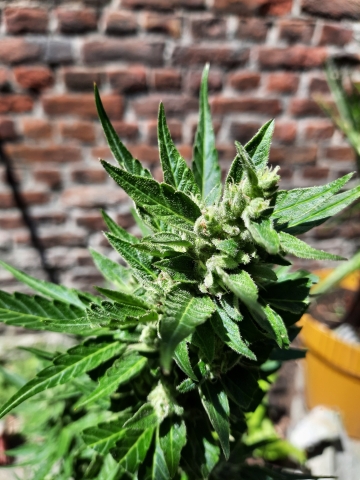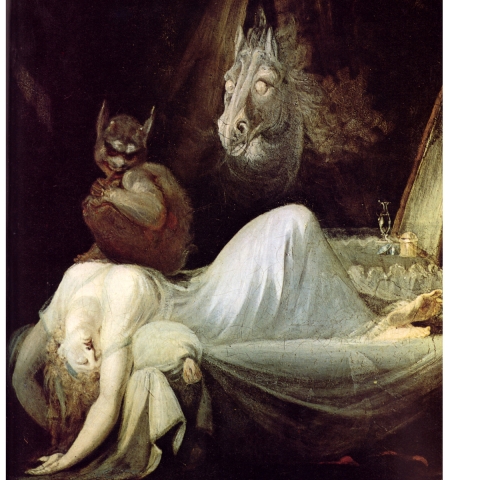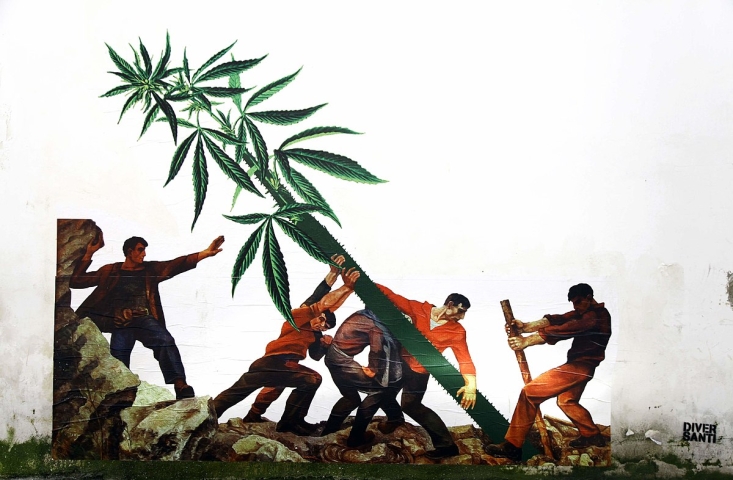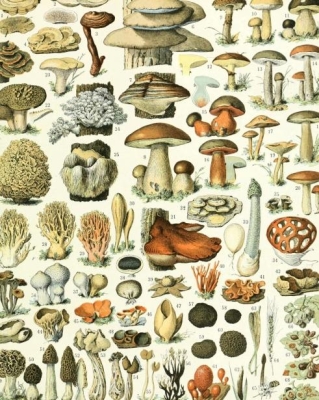Picking medicinal mushrooms with Paul Stamets
The power of mushrooms
On the internet jokes are sometimes made about mycologist Paul Stamets. This smiling man, with beard and glasses, is a pioneer in the field of mushroom research. He likes to talk about it. The way he talks about the mushroom is with so much love, that you'd almost believe there's more to it. According to the clown in question, Paul Stamets himself is a fungus, who has secretly disguised himself in human form, trying to get the world to benefit the fungi kingdom. Has a cordyceps mushroom sometimes taken possession of him and now directs him as a puppet, whispering to mankind that mushrooms are the answer to all possible questions? What is certain is that he is a man with a mycological mission. And that he wants to share his mushroom obsession with as many people as possible. I don't blame him. Maybe I myself am infected with the mushroom syndrome. The bottom line is that I think about mushrooms a lot, dream about them, look for them during forest walks and like to read about them. And talk about it. When I run into a conversation partner who is just as interested in this as I am, I can become very enthusiastic.
According to Paul Stamets mushrooms can save the world
Sometimes someone raises an eyebrow. ‘But what's so interesting about these fungi?’ To this I would like to say: read the book by Paul Stamets: How Mushrooms can help save the world. Or watch the film: Fantastic Fungi, a beautiful documentary in which the ideas of Paul Stamets are made visually and you get a better idea of the gigantic network that this mushroom kingdom contains. The mycologist compares the underground network of mycelium wires with the internet. As in his own words you could call it the 'internet network of nature'. When we walk through a forest we actually only see the tip of the iceberg. Beneath our feet there is a gigantic line of communication, connecting the different organisms that live there. Trees can feed each other from different distances, thanks to the roots that have contact with this network. Information is transmitted in this way, organisms can warn each other and give tips. At the same time, forms of coexistence can arise between different species. In a symbiotic relationship both parties benefit from each other.
Mycelium: natural cleaner of waste
Furthermore, the mycelium is able to repair and purify damaged and contaminated soil. The mycelium produces carbon, nitrogen and other essential elements when it digests dead plant and animal material and replaces it with rich, new soil. Paul Stamets discovered that we can call upon the help of this digestive mechanism of the mycelium. We urgently need a way to clean up our pollution and debris as much as possible. Paul Stamets expresses with his vision that we can rely much more on the power of nature. Mycelium is capable of decomposing and digesting toxic waste (mycoremmendation), catching and lowering silt in riverbeds, as well as pathogens of agricultural watersheds (mycofiltration), controlling insect populations (mycopesticides) and improving the general health of our forests and gardens (mycoforestry and mycogardening). On Youtube you can watch his interesting TED talk. In it he talks about six different ways mushrooms can help save the world. Highly recommended!
Looking for the medicinal mushroom Lion's Mane
The country in which I find myself still contains 'a lot' of nature. For me, as a Dutch person, used to a packed and sacked country, in which I sometimes feel like a sardine in a can, this space is breathtaking. The city park of the capital is so big that you can call it a forest and get lost in it. You can easily take pictures of beautiful mushrooms and forest animals for a whole day without meeting another human being. On beautiful sunny days, the inhabitants of this country like to enjoy a hike and chances are you will meet someone regularly. It strikes me that they are very neat, you see very little garbage lying around and also in terms of noise nuisance it is not that bad. Apparently there are some illegal forest parties here and there in nature, but I haven't come across them yet. What I have encountered is a very special mushroom. Although I had hoped to find this species in the wild before, until now I had to content myself with the organic capsules of Living Nutrition and Mushrooms 4 Life. Both companies produce high quality capsules with the fruiting body and biomass of Hericium erinaceus. Daily intake of these capsules provides the body with the powerful ingredients of this medicinal mushroom. In the Netherlands you don't find the species very often and it's better to leave it standing, should you encounter them anyway. To find her here by chance, growing on a dying tree, was a happy and rare surprise. I felt like a real mycologist when I found out that I had indeed found Hericium erinaceus! Because I knew there were no 'poisonous' lookalikes and I was 100% sure, I harvested them. At home I prepared a delicious dinner with my find. Together with the other residents of this house we ate it.
Picking mushrooms in the wild: a warning
The search for mushrooms in the wild is, as I described before, a true pleasure. While walking I maintain a pleasant focus. I notice that I am more in the Here and Now, because I focus my attention on my surroundings. It is a somewhat slower hike, where I do not just walk from A to B, but absorb everything well and pay less attention to the end goal. Also, I don't start to worry in my head and muse about all the things I still want to do. Finding mushrooms is of course the most fun. I have to admit that, certainly in the beginning, I enthusiastically pulled a fruiting body out of the ground in order to be able to identify it better. You'd like to take a look at the whole mushroom, especially the underside, where you can better see which one you've found. Is it one with gills (plate-shaped?), or are they pores, or teeth? Just pulling a mushroom out of the ground doesn't feel right. It interrupts the life form that was still in its cycle and was beautiful in the forest. Such a mushroom has the important task of spreading spores (the seeds, or DNA), so that it can continue to reproduce.
So the best thing to do is to leave mushrooms standing. If you've now found a clearly edible strain (and you're aware of the potential lookalikes), you might be able to harvest it. More often than not I left an edible variety because I wasn't quite sure. I would like to go for a walk with a mycologist. Most of the time you learn from someone who knows a lot about it and can teach you about it. Reading mushroom books is also a good source of information. For example, you have the fieldwork books you can take with you during your hike, and the more theoretical study books you can read when you sit in your cozy little hole on a rainy autumn day.
Mushrooms 4 Life: Lion's Mane capsules for better concentration
Books that are well worth reading if you are looking for more depth on the effects and growth of medicinal mushrooms, I can recommend Medicinal Mushrooms: The Essential Guide and Medicinal Mushrooms: A Clinical Guide. Before reading, take two Lion's Mane capsules, these can help with learning and concentration. Lion's Mane is a mushroom that has been used for centuries as a medicine for the brain. Science can now tell how this works through research. Lion's Mane stimulates the brain to produce NGF (Nerve Growth Factor). As you get older, brain functions decrease and less NGF is produced. For a healthy and vital brain it is important that NGF is stimulated. In this way, the neurons are kept healthy and the protective layers around the nerves are strengthened. In other words, Lion's Mane is real food for the brain!
Did you enjoy reading this article and do you like to write yourself? We are always looking for people who share our passion for natural products, who can also translate this into great texts. And we have an interesting reward for this. View all information for writers.
 Blog Cannabis
Growers Choice cannabis seeds review
As I was perusing Sirius' seed collection at the beginning of the outdoor growing season, there were a few seed companies that caught my eye. Most [..]
24-06-2020
8 minutes
Blog Cannabis
Growers Choice cannabis seeds review
As I was perusing Sirius' seed collection at the beginning of the outdoor growing season, there were a few seed companies that caught my eye. Most [..]
24-06-2020
8 minutes
 Blog Health
Tips against sleeping problems
Luckily, I'm a regular sleeper. As long as I go to bed on time and get up early, I am in a rhythm in which I find rest. Once in a while I lie awak [..]
19-10-2022
7 minutes
Blog Health
Tips against sleeping problems
Luckily, I'm a regular sleeper. As long as I go to bed on time and get up early, I am in a rhythm in which I find rest. Once in a while I lie awak [..]
19-10-2022
7 minutes
 Blog Cannabis
Different ways to use Cannabis
Every stoner has their own preference. Did you know there are many ways you can enjoy cannabis? Maybe you swear by microdosing cannabis in the morning [..]
Blog Cannabis
Different ways to use Cannabis
Every stoner has their own preference. Did you know there are many ways you can enjoy cannabis? Maybe you swear by microdosing cannabis in the morning [..]













 Nederlands
Nederlands Italiano
Italiano Deutsch
Deutsch Français
Français Português
Português Español
Español Polski
Polski